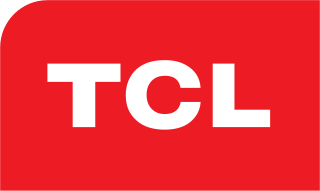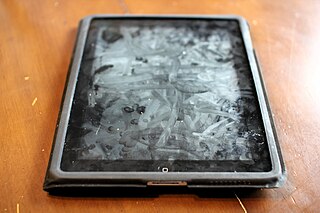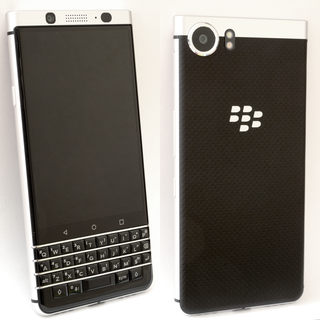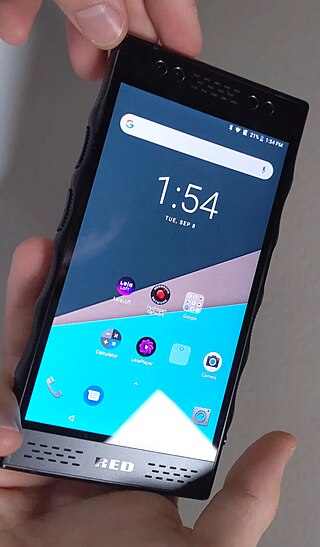
BlackBerry was a brand of smartphones and other related mobile services and devices. The line was originally developed and maintained by the Canadian company BlackBerry Limited from 1999 to 2016, after which it was licensed to various companies.

BlackBerry Limited is a Canadian software company specializing in cybersecurity. Founded in 1984, it developed the BlackBerry brand of interactive pagers, smartphones, and tablets. The company transitioned to providing software and services and holds critical software application patents.

TCL Technology Group Corp. is a Chinese partially state-owned electronics company headquartered in Huizhou, Guangdong Province. It designs, develops, manufactures, and sells consumer products including television sets, mobile phones, air conditioners, washing machines, refrigerators, and small electrical appliances. In 2010, it was the world's 25th-largest consumer electronics producer. It became the second-largest television manufacturer by market share by 2019.
Lipophobicity, also sometimes called lipophobia, is a chemical property of chemical compounds which means "fat rejection", literally "fear of fat". Lipophobic compounds are those not soluble in lipids or other non-polar solvents. From the other point of view, they do not absorb fats.
A mobile operating system is an operating system used for smartphones, tablets, smartwatches, smartglasses, or other non-laptop personal mobile computing devices. While computers such as typical/mobile laptops are "mobile", the operating systems used on them are generally not considered mobile, as they were originally designed for desktop computers that historically did not have or need specific mobile features. This line distinguishing mobile and other forms has become blurred in recent years, due to the fact that newer devices have become smaller and more mobile unlike hardware of the past. Key notabilities blurring this line are the introduction of tablet computers, light laptops, and the hybridization of the two in 2-in-1 PCs.
Dragontrail is an alkali-aluminosilicate sheet glass manufactured by AGC Inc. It is engineered for a combination of thinness, lightness and damage-resistance, similarly to Corning's proprietary Gorilla Glass. The material's primary properties are its strength, allowing thin glass without fragility; its high scratch resistance; and its hardness – with a Vickers hardness test rating of 595 to 673.

A smudge attack is an information extraction attack that discerns the password input of a touchscreen device such as a cell phone or tablet computer from fingerprint smudges. A team of researchers at the University of Pennsylvania were the first to investigate this type of attack in 2010. An attack occurs when an unauthorized user is in possession or is nearby the device of interest. The attacker relies on detecting the oily smudges produced and left behind by the user's fingers to find the pattern or code needed to access the device and its contents. Simple cameras, lights, fingerprint powder, and image processing software can be used to capture the fingerprint deposits created when the user unlocks their device. Under proper lighting and camera settings, the finger smudges can be easily detected, and the heaviest smudges can be used to infer the most frequent input swipes or taps from the user.

The LG G3 is an Android smartphone developed by LG Electronics as part of the LG G series. First released in South Korea on May 28, 2014, it is a successor to 2013's LG G2. Inheriting design elements from the G2, such as its thin screen bezels and rear-mounted power and volume buttons, the G3 is distinguished primarily by being the first smartphone from a major manufacturer to incorporate a 1440p display, and its inclusion of an infrared hybrid autofocus system for its camera. Its video resolution has been upgraded to 2160p (4K). LG also touted the device's plastic "metallic skin"—designed to give the device a higher quality appearance, and a "simpler" user interface with an integrated intelligent personal assistant system. The battery can be quickly changed by the user, allowing charged spare batteries to be carried.

The BlackBerry Priv is a slider smartphone developed by BlackBerry Limited. Following a series of leaks, it was officially announced by BlackBerry CEO John Chen on September 25, 2015, with pre-orders opening on October 23, 2015, for a release on November 6, 2015.
Alcatel ONE TOUCH Idol 3 4.7 and Idol 3 5.5 are Android smartphones manufactured by TCL Mobile and officially unveiled at 2015’s Mobile World Congress. The Idol 3 line up consists of two handsets that use the same design but differ in size and specifications. The Idol 3 4.7 features a 4.7” display while the Idol 3 5.5 has a larger 5.5” display. They're the first smartphones to come with a reversible design that allows the user to use the phone upside-down.

The Samsung Galaxy S7, Samsung Galaxy S7 Edge and Samsung Galaxy S7 Active are Android-based smartphones manufactured, released and marketed by Samsung Electronics. The S7 series serves as the successor to the Galaxy S6, S6 Edge, S6 Edge+ and S6 Active released in 2015. The S7 and S7 Edge were officially unveiled on 21 February 2016 during a Samsung press conference at Mobile World Congress, with a European and North American release on 11 March 2016. The S7 Active was unveiled on 4 June 2016, and released on AT&T in the United States on 10 June 2016.

The Moto G4 is a line of Android smartphones manufactured by Motorola Mobility, a subsidiary of Lenovo. They are the successor to the third-generation Moto G, and were first released in Brazil and India on May 17, 2016, with other markets following.

Moto Z is an Android smartphone developed by Motorola Mobility. Unveiled on June 9, 2016, as its flagship model for the year, the Moto Z is distinguished by the "Moto Mods" technosystem which allows case accessories to be magnetically attached to the device to provide additional functionality. The Moto Z was later joined by the more rugged Moto Z Force of which shares most of the same internals as the former, and the mid-range Moto Z Play with downgraded specifications, all three devices being compatible with the modular system.

Alcatel Idol 4 and Idol 4S are smartphones manufactured by TCL Corporation and marketed by Alcatel Mobile Phones. They were unveiled during Mobile World Congress in February 2016, and are a successor to the Idol 3. The Idol 4 and 4S are positioned as mid-range devices, with the 4S serving as a higher-end model with a faster processor, a larger 1440p display, and a bundled virtual reality headset which serves as the device's packaging.
Moto Z Play is an Android smartphone developed by Motorola Mobility. Unveiled in August 2016 at IFA Berlin, it is a mid-range version of the Moto Z, distinguished primarily by its larger battery. As with the Moto Z, the Z Play is compatible with "MotoMods" accessories that can be magnetically attached to the device to provide additional functionality.

The BlackBerry KeyOne is a touchscreen-based Android smartphone with an integrated hardware keyboard that is manufactured by TCL Corporation under the brand name of BlackBerry Mobile. Originally known by its unofficial code name "Mercury", the KEYone was officially announced at Mobile World Congress in Barcelona on February 25, 2017. While earlier BlackBerry smartphones running Android exist, the KeyOne is the first Android-based BlackBerry with the iconic BlackBerry design. TCL executives termed the KeyOne as a success, mentioning 850,000 units being sold.
BlackBerry Mobile was a trading name that was used by TCL Communication between December 2016 and August 2020 to manufacture and sell BlackBerry branded devices in all world markets, excluding the regions where BB Merah Putih (Indonesia) and Optiemus Infracom operated.

Huawei P20 and Huawei P20 Pro are Android smartphones manufactured by Huawei. Unveiled 27 March 2018, they succeed the Huawei P10 in the company's P series line.

The Samsung Galaxy S10 is a line of Android-based smartphones manufactured, released and marketed by Samsung Electronics as part of the Samsung Galaxy S series. The Galaxy S10 series is the tenth generation of the Samsung Galaxy S, its flagship line of phones next to the Note models, which is also the 10th anniversary of the Galaxy S. Unveiled during the "Samsung Galaxy Unpacked 2019" press event held on 20 February 2019, the devices started shipping in certain regions such as Australia and the United States on 6 March 2019, and internationally on 8 March 2019.

RED Hydrogen One is an Android smartphone manufactured by Red Digital Cinema. It was officially announced on May 18, 2018, with a release date in August 2018. and released in the United States via AT&T and Verizon Wireless on November 2, 2018, after multiple delays.














